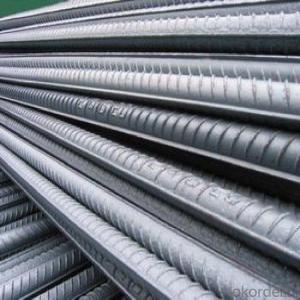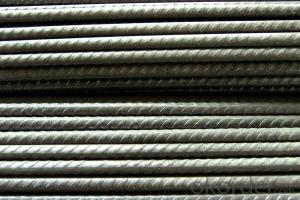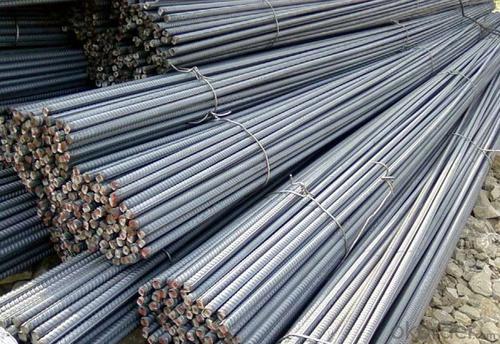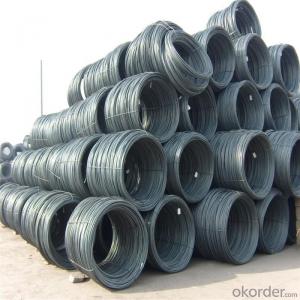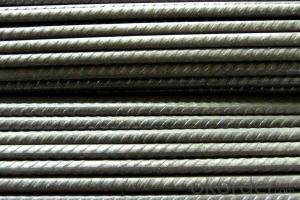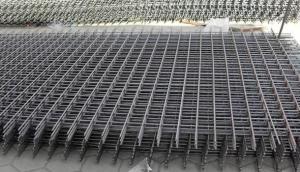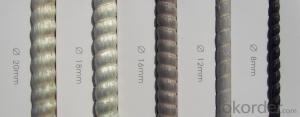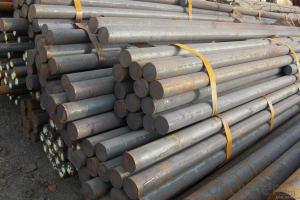Deformed steel bar
- Loading Port:
- China Main Port
- Payment Terms:
- TT OR LC
- Min Order Qty:
- -
- Supply Capability:
- -
OKorder Service Pledge
OKorder Financial Service
You Might Also Like
Product Description:
Specifications of Deformed Steel Bar:
Standard | GB | HRB335, HRB400, HRB500 | |
UK | G460B, B500A, B500B,B500C | | |
USA | GR40, GR60 | | |
Diameter | 6mm,8mm,10mm,12mm,14mm,16mm,18mm,20mm, 22mm,25mm,28mm,32mm,36mm,40mm,50mm | | |
| | |||
Length | 6M, 9M,12M or as required | | |
Place of origin | Hebei, China mainland | | |
Application | building,construction,road,bridge etc | | |
Brand name | DRAGON | | |
Theoretical weight and section area of each diameter as below for your information:
Diameter(mm) | Section area (mm²) | Mass(kg/m) |
6 | 28.27 | 0.222 |
8 | 50.27 | 0.395 |
10 | 78.54 | 0.617 |
12 | 113.1 | 0.888 |
14 | 153.9 | 1.21 |
16 | 201.1 | 1.58 |
18 | 254.5 | 2.00 |
20 | 314.2 | 2.47 |
22 | 380.1 | 2.98 |
25 | 490.9 | 3.85 |
28 | 615.8 | 4.83 |
32 | 804.2 | 6.31 |
36 | 1018 | 7.99 |
40 | 1257 | 9.87 |
50 | 1964 | 15.42 |
Usage and Applications of Deformed Steel Bar:
Deformed bar is widely used in buildings, bridges, roads and other engineering construction. Big to highways, railways, bridges, culverts, tunnels, public facilities such as flood control, dam, small to housing construction, beam, column, wall and the foundation of the plate, deformed bar is an integral structure material. With the development of world economy and the vigorous development of infrastructure construction, real estate, the demand for deformed bar will be larger and larger..
Packaging & Delivery of Deformed Steel Bar:
Packaging Detail: products are packed in bundle and then shipped by container or bulk vessel, deformed bar is usually naked strapping delivery, when storing, please pay attention to moisture proof. The performance of rust will produce adverse effect.
Each bundle weight: 2-3MT, or as required
Payment term: TT or L/C
Delivery Detail: within 45 days after received advanced payment or LC.
Label: to be specified by customer, generally, each bundle has 1-2 labels
Trade terms: FOB, CFR, CIF
Deformed Steel Bar in Coil
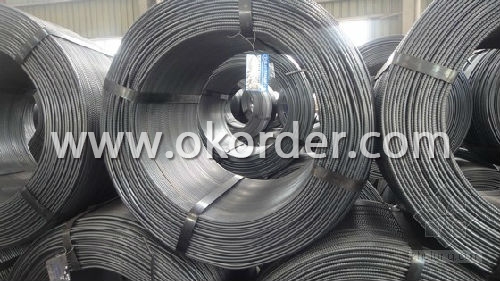
Produce Line of Deformed Steel Bar
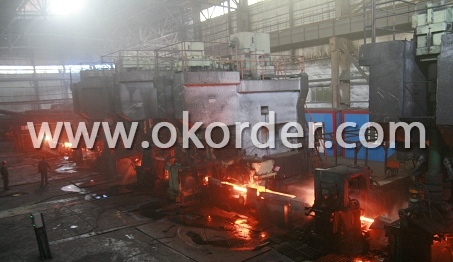
Note:
1. Our products are produced according to national standard (GB), if not, supply according to national standards (GB) or agreement as customer required.
2. Other Grade and Standard Deformed Steel Bar we can supply:
Grade: GR40/GR60, G460B/B500A/B500B/B500C,BST500S
Standard: ASTM, BS, DIN
The Minimum Order Quantity of these products is high, and need to be confirmed.
3. We can not only supply Deformed Steel Bar; if you need anything about building materials, please contact us for further information.
4. Please send us your detail specifications when inquire. We will reply to you as soon as possible. We sincerely hope we can establish a long stable business relationship.
- Q: What is the effect of steel rebars on the thermal conductivity of concrete?
- The effect of steel rebars on the thermal conductivity of concrete is generally negligible. While steel has a higher thermal conductivity than concrete, the relatively low volume fraction of rebars in typical reinforced concrete structures does not significantly impact the overall thermal conductivity of the material.
- Q: Are there any environmental concerns related to steel rebars?
- Yes, there are some environmental concerns related to steel rebars. The production of steel requires significant amounts of energy and releases carbon dioxide emissions, contributing to climate change. Additionally, the extraction of iron ore and other raw materials for steel production can cause habitat destruction and depletion of natural resources. However, steel rebars are also highly recyclable, reducing the need for new steel production and minimizing environmental impact.
- Q: How do steel rebars affect the overall cost of maintenance and repairs?
- Various structures can experience a noticeable impact on maintenance and repair costs due to the presence of steel rebars. The utilization of steel rebars is quite common in reinforcing concrete structures such as buildings, bridges, and highways. These rebars provide concrete with added strength and durability, effectively preventing cracks and structural failures. In terms of maintenance, steel rebars play a vital role in reducing the frequency and expenses associated with repairs. By reinforcing the concrete, rebars assist in distributing stress and load evenly, therefore minimizing the likelihood of structural damage. Consequently, property owners and infrastructure managers can save both time and money as maintenance and repair efforts become less frequent. Furthermore, the presence of steel rebars significantly contributes to the overall longevity of structures. By preventing cracks and other forms of damage, rebars effectively extend the lifespan of the concrete. Consequently, costly and extensive repairs, or even complete structure replacements, become less necessary over time. However, it is important to acknowledge that steel rebars themselves may require maintenance. Over time, rebars can corrode due to exposure to moisture, chemicals, or environmental factors. Consequently, the integrity of the structure can be compromised as the rebars weaken. Therefore, periodic inspection and maintenance of the rebars become necessary to prevent any potential issues. In conclusion, the impact of steel rebars on maintenance and repair costs is significant. While they enhance the strength and durability of structures, reducing the need for frequent repairs, they also require their own maintenance to prevent corrosion. By properly maintaining steel rebars, the lifespan of structures can be extended, resulting in long-term cost savings.
- Q: What is the process of deforming steel rebars for better adhesion with concrete?
- The process of deforming steel rebars for better adhesion with concrete is known as ribbing or rib deformation. This process involves creating small ridges or raised patterns along the surface of the rebar, which enhances the bond between the concrete and the steel. The ribbing process is typically performed through a mechanical operation called cold rolling. Cold rolling is a metalworking process where the steel rebar is passed through a series of rollers, which exert pressure on the surface and cause plastic deformation. The rollers are designed with specific patterns or configurations that create the desired ribbing on the rebar. The purpose of ribbing is to increase the surface area of the rebar in contact with the concrete. The ridges or patterns created by the ribbing process provide additional points of adhesion for the concrete to grip onto, significantly improving the bond strength between the two materials. This enhanced bond is crucial for reinforcing concrete structures, as it helps to distribute loads and resist tensile forces. The ribbing process is commonly used in the construction industry for reinforcing concrete structures such as beams, columns, and slabs. The specific pattern and depth of the ribbing may vary depending on the project requirements and the type of rebar being used. Manufacturers often adhere to industry standards and guidelines to ensure the proper design and placement of ribbed rebars. In summary, the process of deforming steel rebars for better adhesion with concrete involves ribbing or creating ridges on the rebar's surface. This is achieved through cold rolling, where the rebar is passed through rollers designed with specific patterns. Ribbing increases the surface area and provides additional points of adhesion, improving the bond between the concrete and the rebar.
- Q: Can steel rebars be used in underground parking garage construction?
- Indeed, steel rebars find utility in the construction of underground parking garages. They are frequently employed in the reinforcement of concrete structures, including those built below the ground level. By endowing the concrete with strength and reinforcement, the rebars enable it to withstand the immense weight and pressure exerted by the structure above. Moreover, steel rebars possess remarkable resistance to corrosion—a quality of utmost significance in subterranean environments where moisture and other corrosive agents are likely to exist. In summary, steel rebars emerge as a dependable and widely preferred option for reinforcing concrete during the construction of underground parking garages.
- Q: What is the role of steel rebars in ensuring occupant safety?
- Steel rebars play a crucial role in ensuring occupant safety in various structures, particularly in buildings and infrastructure. These reinforced steel bars are commonly used in concrete construction to enhance the strength and durability of the structure, ultimately safeguarding the individuals residing or working within them. The primary function of steel rebars is to provide structural reinforcement to concrete elements, such as columns, beams, and slabs. By incorporating rebars into the concrete, the overall load-bearing capacity of the structure is significantly increased, allowing it to withstand various external forces and loads. This greatly reduces the risk of collapse or structural failure, which could potentially harm the occupants. During seismic events, such as earthquakes, steel rebars play a critical role in dissipating and distributing the energy exerted on the structure. The ductility and tensile strength of steel allow it to absorb and distribute the seismic forces, reducing the chances of a sudden structural failure. This ensures that the occupants are protected from the potential hazards associated with seismic activity. Moreover, steel rebars enhance the fire resistance of concrete structures. While concrete itself possesses good fire-resistant properties, the inclusion of steel rebars further reinforces this resistance. Steel has a high melting point, and its thermal conductivity is relatively low compared to other materials. This means that steel rebars can withstand high temperatures for an extended period, ensuring the structural integrity of the building during a fire and providing occupants with a safe evacuation route. In addition to their structural benefits, steel rebars also contribute to the long-term durability and maintenance of the structure. By preventing cracks and minimizing the effects of corrosion, rebars help maintain the structural integrity of the concrete over time. This ensures that the occupants are not exposed to potential hazards caused by the deterioration of the structure. Overall, the role of steel rebars in ensuring occupant safety is indispensable. They provide structural reinforcement, increase load-bearing capacity, enhance fire resistance, and contribute to the long-term durability of a structure. By incorporating steel rebars into concrete construction, the risk of collapse, structural failure, and other potential hazards is significantly reduced, ultimately providing a safe environment for the occupants.
- Q: What are the advantages of using composite steel rebars?
- There are several advantages of using composite steel rebars. Firstly, composite steel rebars offer higher tensile strength compared to traditional steel rebars, making them more durable and resistant to deformation. Secondly, they have a lower coefficient of thermal expansion, reducing the risk of cracking and improving long-term performance. Additionally, composite steel rebars are corrosion-resistant, ensuring a longer lifespan and lower maintenance costs. Furthermore, these rebars are lighter in weight, making them easier to handle and transport. Lastly, composite steel rebars can be easily fabricated and installed, allowing for greater design flexibility and faster construction.
- Q: Are steel rebars suitable for reinforcement in historical monuments?
- Steel rebars may not be suitable for reinforcement in historical monuments. The use of steel rebars can cause damage to the structural integrity and aesthetics of these monuments. Traditional materials and techniques that are compatible with the existing structure should be considered instead, to ensure the preservation and authenticity of these historical sites.
- Q: What is the minimum lap length required for steel rebars in concrete?
- The minimum lap length required for steel rebars in concrete is typically determined by local building codes and design specifications. These requirements may vary depending on factors such as the diameter of the rebar, the type of concrete being used, and the intended structural application. It is important to consult the relevant codes and design guidelines to determine the specific minimum lap length for a given project.
- Q: How do steel rebars affect the durability of a structure?
- The durability of a structure is greatly influenced by steel rebars. These reinforcements, which are made of high-strength steel, are embedded in concrete to improve its tensile strength and overall structural integrity. Steel rebars prevent structural failures and ensure the long-term durability of the construction by resisting cracking and flexural stresses. One of the main advantages of using steel rebars is their ability to withstand tension forces. While concrete is strong in compression, it is weak in tension. When a structure is subjected to loads that cause bending or stretching, the rebars distribute these forces throughout the concrete, preventing it from cracking or breaking. This reinforcement enhances the load-bearing capacity of the structure, making it more resistant to external forces like earthquakes or strong winds. Furthermore, steel rebars also play a critical role in preventing corrosion within the structure. Concrete is porous, and with time, moisture can infiltrate it, leading to rusting of the embedded reinforcement. Rusting rebars expand, resulting in cracks and weakening of the structure. However, by using rebars that are resistant to corrosion, such as epoxy-coated or stainless steel rebars, the risk of corrosion is significantly reduced, thus improving the durability of the structure. In addition to their mechanical properties, steel rebars also contribute to the durability of a structure in terms of construction speed and long-term maintenance. Compared to other traditional reinforcement materials, rebars are relatively easy to install, reducing construction time and costs. Furthermore, their long lifespan and minimal maintenance requirements ensure the longevity and durability of the structure over time. To conclude, steel rebars are indispensable for guaranteeing the durability of a structure. Their ability to withstand tension forces, prevent cracking, and mitigate the risk of corrosion greatly enhances the structural integrity and longevity of the construction. It is crucial to incorporate steel rebars into the design and construction process to create robust, secure, and long-lasting structures.
Send your message to us
Deformed steel bar
- Loading Port:
- China Main Port
- Payment Terms:
- TT OR LC
- Min Order Qty:
- -
- Supply Capability:
- -
OKorder Service Pledge
OKorder Financial Service
Similar products
Hot products
Hot Searches
Related keywords

